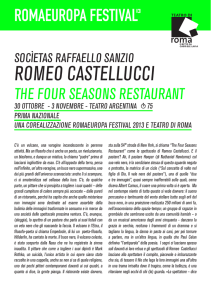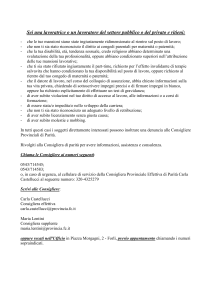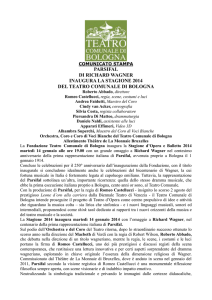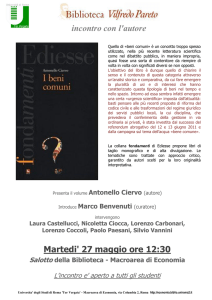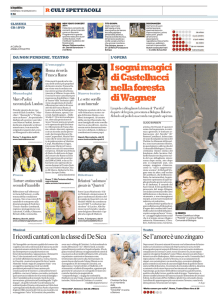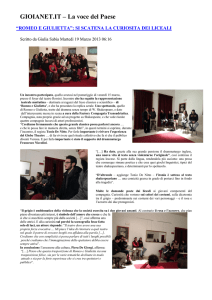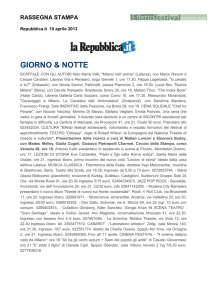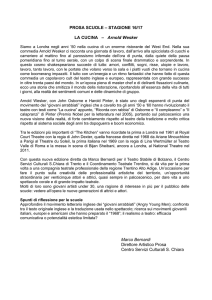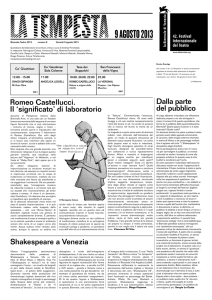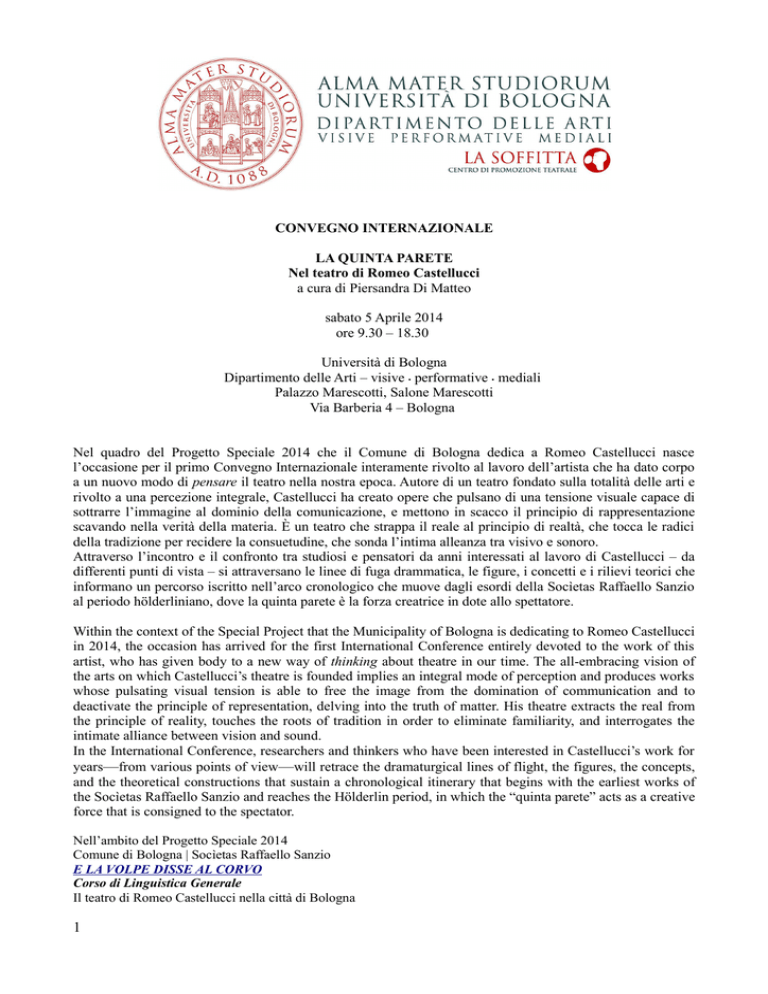
CONVEGNO INTERNAZIONALE
LA QUINTA PARETE
Nel teatro di Romeo Castellucci
a cura di Piersandra Di Matteo
sabato 5 Aprile 2014
ore 9.30 – 18.30
Università di Bologna
Dipartimento delle Arti – visive performative mediali
Palazzo Marescotti, Salone Marescotti
Via Barberia 4 – Bologna
Nel quadro del Progetto Speciale 2014 che il Comune di Bologna dedica a Romeo Castellucci nasce
l’occasione per il primo Convegno Internazionale interamente rivolto al lavoro dell’artista che ha dato corpo
a un nuovo modo di pensare il teatro nella nostra epoca. Autore di un teatro fondato sulla totalità delle arti e
rivolto a una percezione integrale, Castellucci ha creato opere che pulsano di una tensione visuale capace di
sottrarre l’immagine al dominio della comunicazione, e mettono in scacco il principio di rappresentazione
scavando nella verità della materia. È un teatro che strappa il reale al principio di realtà, che tocca le radici
della tradizione per recidere la consuetudine, che sonda l’intima alleanza tra visivo e sonoro.
Attraverso l’incontro e il confronto tra studiosi e pensatori da anni interessati al lavoro di Castellucci – da
differenti punti di vista – si attraversano le linee di fuga drammatica, le figure, i concetti e i rilievi teorici che
informano un percorso iscritto nell’arco cronologico che muove dagli esordi della Socìetas Raffaello Sanzio
al periodo hölderliniano, dove la quinta parete è la forza creatrice in dote allo spettatore.
Within the context of the Special Project that the Municipality of Bologna is dedicating to Romeo Castellucci
in 2014, the occasion has arrived for the first International Conference entirely devoted to the work of this
artist, who has given body to a new way of thinking about theatre in our time. The all-embracing vision of
the arts on which Castellucci’s theatre is founded implies an integral mode of perception and produces works
whose pulsating visual tension is able to free the image from the domination of communication and to
deactivate the principle of representation, delving into the truth of matter. His theatre extracts the real from
the principle of reality, touches the roots of tradition in order to eliminate familiarity, and interrogates the
intimate alliance between vision and sound.
In the International Conference, researchers and thinkers who have been interested in Castellucci’s work for
years—from various points of view—will retrace the dramaturgical lines of flight, the figures, the concepts,
and the theoretical constructions that sustain a chronological itinerary that begins with the earliest works of
the Socìetas Raffaello Sanzio and reaches the Hölderlin period, in which the “quinta parete” acts as a creative
force that is consigned to the spectator.
Nell’ambito del Progetto Speciale 2014
Comune di Bologna | Socìetas Raffaello Sanzio
E LA VOLPE DISSE AL CORVO
Corso di Linguistica Generale
Il teatro di Romeo Castellucci nella città di Bologna
1
elavolpedissealcorvo.it
Programma
h 9.30
Saluti
Giuseppina La Face
Direttore del Dipartimento delle Arti visive performative mediali
Alberto Ronchi
Assessore alla Cultura del Comune di Bologna
Introduzione
Marco De Marinis
Responsabile scientifico del Centro La Soffitta
h 10.00
On Learning to Forget
Imparare a dimenticare
Joe Kelleher (Roehampton University-London)
Bad Images
Le immagini cattive
Dorota Semenowicz (Jagiellonian University in Kraków)
On the Atmosphere: The Logic of Sound and Colour in the theatre
of the Socìetas Raffaello Sanzio
Dell’atmosfera: logica del suono e del colore nel teatro
della Socìetas Raffaello Sanzio
Enrico Pitozzi (Università di Bologna)
Νyx Teleia: A Descent into the Dark Depths of the Ancient Greek World
Νyx teleia: una discesa nelle profondità oscure del Mondo Greco Antico
Eleni Papalexiou (University of the Peloponnese)
The Art of Catastrophe: On The Phenomenon Called I created by Romeo Castellucci in the Wake of Great
Earthquake in Eastern Japan
L’Arte della Catastrofe: su The Phenomenon Called I creato da Romeo Castellucci dopo il grande terremoto
del Giappone orientale
Shintaro Fujii (Waseda University-Tokyo)
Modera Piersandra Di Matteo
h 15.00
A Room for Endless Potentiality: the Future and Romeo Castellucci’s Theatre
Una stanza di Possibilità Infinite: il futuro e il teatro di Romeo Castellucci
Daniel Sack (Florida State University)
The figure of Antonin Artaud in the Epopea della polvere
La figura di Antonin Artaud nell’Epopea della polvere
Lucia Amara (Università di Bologna)
The Treatre of Body, the Liberated Enigma
Il teatro del corpo, l’enigma liberato
Marcello Neri (University of Flensburg)
2
The Theatre of Objects: The Voice, the Gaze, Food, Excrement, Trash, Nothingness
Il teatro degli Oggetti: voce, sguardo, cibo, escrementi, spazzatura, il niente
Marie Hélène Brousse (Université Paris VIII)
To Carthage Then Came a Curator
A Cartagine poi venne un curatore
Adele Cacciagrano (Università di Bologna)
Modera Tihana Maravic
Conclusioni
Joe Kelleher (Roehampton University-London)
On Learning to Forget
The talk will consider the experience of the spectator in recent works by Castellucci such as Sul concetto di
volto nel Figlio di Dio, Uso Umano di esseri umani and the Friedrich Hölderlin adaptations (The Four
Seasons Restaurant and Hyperion: Letters of a Terrorist), in particular in relation to questions of image and
language. Sul concetto di volto, for example, exhibits the banality of a performed action repeated ad
nauseam in the glow of a writing (literally illuminated on stage) that expresses an aporia of thought, which
may or may not succeed the rendered scene. Uso Umano di esseri umani, through the levels of the
Generalissima, challenges the spectator to compact reflection and the life of thought in the imageless time
that comes after the event, or after the life of appearance as such. In each of these pieces there is enacted
something like a gesture of effacement, a removal of self and image as if for the sake of the continuation of
other people’s thought. A sort of exploded tutelage, perhaps. Or a lesson in forgetting.
Imparare a dimenticare
L’intervento prenderà in considerazione l’esperienza dello spettatore nelle recenti opere di Romeo
Castellucci come Sul concetto di volto nel Figlio di Dio, Uso Umano di esseri umani e gli adattamenti da
Friedrich Hölderlin (The Four Seasons Restaurant e Hyperion. Letters of a Terrorist), in particolare in
relazione alle questioni relative all’immagine e al linguaggio. Sul concetto di volto, per esempio, mostra la
banalità di un’azione ripetuta fino alla nausea nel bagliore di una scritta (letteralmente illuminata in scena),
che esprime una aporia del pensiero, che può o non può soppiantare la scena raffigurata. Uso Umano di
esseri umani, attraverso i livelli della lingua Generalissima, sfida lo spettatore a una riflessione compatta e la
vita del pensiero nel tempo senza immagine che succede all’evento, o dopo la vita di tale apparizione. In
ognuna di questi lavori è messo in scena qualcosa come un gesto di cancellazione, una rimozione del sé e
dell’immagine, come se fosse per il bene della continuazione del pensiero di altre persone. Una sorta di tutela
esplosa, forse. O una lezione di oblio.
Dorota Semenowicz (Jagiellonian University in Kraków)
Bad Images
Why might an image be bad? The word bad relates to its ethical dimension. The images of Romeo
Castellucci’s theatre call upon us, want to be seen—even more, they need to be seen as they exist only when
confronted with the spectator’s gaze. The starting point of the talk will be the performance Purgatorio
(2008). It is constructed around the image of a rape which is not shown. It exists only in the spectator’s mind.
The scene of the rape reveals and tears apart not only the whole representation (bourgeois family life), but
also the subject that observes it. It is no longer possible to separate the subject from the world presented on
the stage, the inside from the outside, the visible from the invisible, the conscious from the unconscious. The
spectator puts the image into motion with his gaze but does not control it. What is a stake in that negotiation
between the image and the spectator? How does he proceed to elicit both admiration and shame from the
3
spectator, fascination and protest, delight and anger? The images in Romeo Castellucci’s theatre intentionally
provoke a conflict within the spectator. They are bad because they do not give us choice.
Le immagini cattive
Perché un’immagine può essere cattiva? La parola “cattivo” rimanda a una dimensione etica. Le immagini
del teatro di Romeo Castellucci ci chiamano in causa, vogliono essere viste, e più ancora, esse hanno
bisogno di essere viste perché esistono solo quando si confrontano con lo sguardo dello spettatore.
L’intervento prende le mosse dal Purgatorio (2008). Lo spettacolo è costruito intorno all’immagine di uno
stupro non mostrato. Vive solo nella mente dello spettatore. La scena dello stupro non solo rivela e lacera
l’intera rappresentazione (l’interno di un ambiente familiare borghese), ma anche il soggetto che osserva.
Non è più possibile separare il soggetto dal mondo presentato sulla scena, l’interno dall’esterno, il visibile
dall’invisibile, il conscio dall’inconscio. Lo spettatore mette l’immagine in movimento con il suo sguardo,
ma non lo controlla. Cosa è in gioco in questa negoziazione tra l’immagine e lo spettatore? Come riesce a
evocare nello spettatore al contempo ammirazione e vergogna, fascino e protesta, gioia e rabbia? Le
immagini nel teatro di Romeo Castellucci intenzionalmente provocano un conflitto nello spettatore. Sono
cattive perché non ci danno scelta.
Enrico Pitozzi (Università di Bologna)
On Atmosphere: The Logic of Sound and Colour in the Theatre of the Socìetas Raffaello Sanzio
The aim of this paper is to analyse, through an exploration of the artistic production of the Socìetas Raffaello
Sanzio, the aspects related to a definition of acoustic image as well as that of a theatre of colour. Onstage,
forms, sounds, and colours seem to give rise to a problem about vision: they call it into question, and, after
all, theatre is the place of vision. So the point is to question what one sees at theatre: the epiphany of entities
could be an answer. It is exactly in this sense that the acoustic image can emerge, like a texture of the scene
that allows the visual optical image to take shape. Sound—just like colour—represents the scene’s
temperature; they reorient the perceptive faculties of the spectator, becoming a sort of immersive sensation to
be inhabited. From this standpoint, to talk of atmosphere in a theatrical sense is to consider some acoustic
and chromatic elements that extend and persist by acting on all the points of the scenic device in a latent way.
Since an atmosphere is something diffused, it is also deep and almost imperceptible: what can be detected
are chromatic variations, sound pulsations, light, and acoustic figures.
Dell’atmosfera: logica del suono e del colore nel teatro della Socìetas Raffaello Sanzio
Attraversando la produzione della Socìetas Raffaello Sanzio, questo intervento intende analizzarne gli aspetti
legati alla definizione di un’immagine acustica e di un teatro del colore. In scena, la forma, il suono e il
colore pongono un problema di visione, la interrogano. D’altronde il teatro è il luogo della visione. La
questione è, semmai, cosa si vede a teatro: l’epifania degli enti potrebbe essere la risposta. È in questa logica
che emerge l’immagine acustica come texture della scena che permette all’immagine ottico-visiva di
delinearsi. Il suono – così come il colore – sono la temperatura della scena, riorientano le facoltà percettive
dello spettatore che in loro si immerge come in una sensazione da abitare. Da qui, parlare dell'atmosfera in
teatro significa riferirsi a una serie di elementi sonori e cromatici che si estendono nella durata, operando su
tutti i punti del dispositivo scenico in modo latente. Proprio perché diffusa, un’atmosfera è impercettibile e
profonda: ad affiorare sono cromie, pulsazioni sonore, figure acustiche e di luce.
Eleni Papalexiou (University of the Peloponnese)
Νyx Teleia: A Descent into the Dark Depths of the Ancient Greek World
From the Eleusinian Mysteries to classical tragedy, from animal rituals to Platonic philosophy and to the
workings of the city-state, the Ancient Greek world is ever present in the theatre of Romeo Castellucci.
Words, meanings, and concepts, such as nyx teleia, epopteia, sygē, katabasis, pharmakon, run through his
work and thinking, in a constant attempt to connect and—at the same time—break with the past. In his own
words: “One must discover the roots to be able to cut them.” In this paper I shall endeavour to descend into
the “perfect darkness” of Castellucci’s universe, in search of the traces of Ancient Greek thought in his
4
writings and performances. The problem will thus be to examine the ways in which, through a sequence of
continuities and breaks, his theatre redefines its relation to its origins.
Νyx teleia: una discesa nelle profondità oscure del Mondo Greco Antico
Dai Misteri Eleusini alla tragedia classica, dai rituali animali alla filosofia platonica e al funzionamento della
città-stato, il mondo greco antico è sempre presente nel teatro di Romeo Castellucci. Parole, significati e
concetti, come nyx teleia, epopteia, sygē, katabasis, pharmakon, percorrono il suo lavoro e il suo pensiero, in
un continuo tentativo di connettersi e – allo stesso tempo – rompere con il passato. Nelle sue parole:
“bisogna scoprire le radici per essere in grado di reciderle”. In questo articolo cercherò di scendere nel “buio
perfetto” dell’universo di Castellucci, alla ricerca delle tracce del pensiero greco antico nei suoi scritti e
spettacoli. Si tratta quindi di esaminare i modi in cui, attraverso una sequenza di continuità e rotture, il suo
teatro ridefinisce il suo rapporto con le sue origini.
Shintaro Fujii (Waseda University)
The Art of Catastrophe: On The Phenomenon Called I, Directed by Romeo Castellucci in the Wake of the
Great East Japan Earthquake
Romeo Castellucci directed The Phonomenon Called I, inspired by the poem by Kenji Miyazawa, for the
2011 Festival/Tokyo, only six months after a powerful earthquake struck Japan and caused serious
destruction of the region where the poet comes from. The performance took place in an outdoor space, a
circular park located in Tokyo Bay, in the centre of which a large number of white empty chairs were placed
in an orderly fashion and then moved away, as if driven by an invisible force. It left the audience with a
strong sense of community/communion, being united by loss, as symbolised by a white flag that each person
in the audience was asked to carry and, at a given moment, wave. This presentation will focus on the way the
absent was brought into theatre and will try to analyse the stakes in this performance (and other works by
Castellucci) in light of catastrophe, a term which, synonymous with peripeteia, has its roots in theatre.
L’Arte della Catastrofe: su The Phenomenon Called I creato da Romeo Castellucci dopo il Grande
Terremoto del Giappone orientale
Nel 2011 Romeo Castellucci ha diretto The Phonomenon Called I, ispirato al poema di Kenji Miyazawa, per
il Festival di Tokyo, sei mesi dopo il potente terremoto che ha colpito il Giappone e provocato gravi
distruzioni nella regione d’origine del poeta. La performance ha avuto luogo in uno spazio all’aperto, in un
parco circolare situato nella baia di Tokyo, nel centro della quale sono state collocate in modo ordinato un
gran numero di sedie bianche vuote e poi rimosse come guidate da una forza invisibile. Questa azione ha
suscitato nel pubblico un forte senso di comunità/comunione, essendo uniti da una perdita, come
simboleggiato da una bandiera bianca consegnata a ogni spettatore a cui è stato chiesto, in un dato momento,
di sventolare. Questo intervento si concentrerà sul modo in cui l’assenza entra nello spettacolo e cercherà di
analizzare la posta in gioco di questa performance (e in altri lavori di Castellucci) alla luce della nozione di
catastrofe, termine che, sinonimo di peripezia, ha le sue radici nel teatro.
Daniel Sack (Florida State University)
A Room for Endless Potentiality: the Future and Romeo Castellucci’s theatre
“Genesis scares me more than the Apocalypse: the terror of endless possibility, the open sea of potential.”
Romeo Castellucci
In the moments before the curtain rises, in the dark of the blackout before the first light finds a form, theatre
withholds its many worlds on the verge of appearance. How can a performance sustain this sense of
potentiality that grounds all live production? How might the blank page of theatre contain its unwritten
future statements? This talk suggests some of the contours of Romeo Castellucci’s singular engagement with
the futurity of the live event by looking at what is among his most purified statements: one of the ten-minute
site-specific Crescita [“tendrils”] from the Tragedia Endogonidia cycle (2002–2004). The performance
expresses the essential movement of theatre—its suspension between appearance and disappearance, creation
and destruction—in the starkest terms. It thus functions as a parable not only for Castellucci’s larger body of
work, but also for theatre as an art inherently involved in the making and unmaking of worlds.
5
Una stanza di potenzialità infinite: il futuro e il teatro di Romeo Castellucci
“La Genesi mi spaventa di più dell’Apocalisse: il terrore delle possibilità infinite, il mare aperto delle possibilità”.
Romeo Castellucci
Nei momenti prima che il sipario si alzi, nel buio del blackout prima che la prima luce prenda forma, il teatro
trattiene i suoi numerosi mondi sull’orlo dell’apparire. Come può una performance sostenere questo senso di
potenza che fonda tutta la produzione dal vivo? Come potrebbe la pagina bianca del teatro contenere le
pronunce non ancora scritte? Questo intervento suggerisce alcuni dei contorni del singolare modo di Romeo
Castellucci di rapportarsi con la futurità dell’evento dal vivo, guardando alle sue più pure manifestazioni:
una Crescita site-specific di dieci minuti dal ciclo Tragedia Endogonidia (2002-2004). La performance
esprime il movimento essenziale del teatro – la sua sospensione tra apparizione e scomparsa, creazione e
distruzione – nei termini più crudi. E questa funge da parabola, non solo per l’intero corpo dei lavori di
Castellucci, ma anche per il teatro come un’arte intrinsecamente tesa a fare e disfare mondi.
Lucia Amara (Università di Bologna)
The figure of Antonin Artaud in the Epopea della polvere
In the cycle Epopea della polvere (1992-1999), the figure of Antonin Artaud bears the meaning conferred on
it in the Biblical Christian tradition. Artaud makes his first appearance at a central point in Orestea (una
commedia organica?), when the Rabbit tells of the fall of Ifigenia-Alice, the two virgins mythologically
associated with the cliff (“a katabasis of things and words”, says Romeo Castellucci). Indeed, Carroll’s
enigmatic poem “Jabberwocky,” written in pseudo-Runic, is followed by the glossolalic translation-variation
that Artaud wrote in the madhouse in Rodez. The word falls, flops down, straddles—its meaning is lost.
Artaud’s scream—the acutely high-pitched one (at 1200 hertz) of the radio show Per farla finita col giudizio
di dio (“To Have Done with the Judgment of God”)—will punctuate Act II of Genesis: From the Museum of
Sleep, a play named for Auschwitz. In the Epopea della polvere, in order for the Word to fall, it is necessary
to turn to bodily matter and lowercase the word God. Antonin Artaud is a figure of the body.
La figura di Antonin Artaud nell’Epopea della polvere
Nel ciclo dell’Epopea della polvere (1992-1999) Antonin Artaud è una figura nel significato che questa
assume nella tradizione biblico-cristiana. Serve per coprire, svelare, anticipare o prefigurare. Artaud si
mostra per la prima volta in un momento centrale di Orestea (una commedia organica?) quando il Coniglio
racconta la caduta di Ifigenia-Alice, le due vergini associate mitologicamente allo strapiombo (“una catabasi
di cose e parole”, dice Romeo Castellucci): di fatti all’enigmatico poemetto carrolliano Jabberwocky, scritto
in pseudo-runico, segue la traduzione/variazione glossolalica che Artaud fece nel manicomio di Rodez. La
parola cade, si accascia, si mette di traverso, se ne perde il senso. L’urlo di Artaud – quello acutissimo a 1200
hertz della trasmissione radiofonica Per farla finita col giudizio di dio – scandirà l’atto secondo di Genesi.
From the museum of sleep, intitolato ad Auschwitz. Nell’Epopea della polvere per far cadere la Parola è
necessario passare dalla materia corporea e mettere in minuscolo Dio. Antonin Artaud è figura del corpo.
Marcello Neri (University of Flensburg)
The Treatre of Body, the Liberated Enigma
What has emerged across the landscape of Romeo Castellucci’s works is a bodily theatre proper (with its
movements and its postures), a theatre that develops its own discourse—nonlogical, nonsemantic, but
brimming with semiosis—which utters and speaks, but above all it shows something other than words. Here
the body shows itself to be liberated from the superstructures of logos, from the domestication of culture, so
that, even as the body remains an enigma to be solved, it nonetheless reveals itself without the “chains” that
bend it to a discourse other than its own, something superimposed. There comes into play the distinction
between the enigma-body and the body qua enigma. Unfolding in the foreground is the paradox of the body
as something without which there can be no performance or enactment (theatrical or otherwise), this
precisely at the time that the non-representability of the body is brought to the stage. Some teleological
6
categories that in theology can remain abstract figures (embodiment, the representation of God, the
Eucharist/transubstantiation) move through Castellucci’s theatre finding a realistic liberation in some
remarks or bodily uses because they are provocative by virtue of an extreme sense of touch.
Il teatro del corpo, l’enigma liberato
Nell’attraversare gli spettacoli di Romeo Castellucci è emerso un vero e proprio teatro del corpo (con i suoi
movimenti e le sue posture) che sviluppa il suo proprio discorso – non logico, non semantico, ma pieno di
semiosi – che dice, parla, soprattutto mostra altro dalle parole. Qui il corpo appare liberato dalle
sovrastrutture del logos, dagli addomesticamenti della cultura, così che pur rimanendo un enigma irrisolto si
rivela, non di meno, senza più “catene” che lo piegano a un discorso non suo, ma su di lui. Si pone la
distinzione del corpo-enigma e del corpo come enigma. In primo piano vive il paradosso del corpo come
imprescindibile per la rappresentazione (non solo quella teatrale), nel momento stesso in cui mette in scena la
non rappresentabilità del corpo stesso. Alcune categorie teologiche (incarnazione, rappresentazione di Dio,
eucaristia/transustanziazione), che nella teologia possono rimanere figure astratte, percorrono il teatro di
Castellucci trovando una liberazione realistica in alcuni cenni/usi corporei perché provocativi con estremo
tatto.
Marie Hélène Brousse (Université Paris VIII)
The Theatre of Objects: The Voice, the Gaze, Food, Excrements, Trash, Nothingness
There is a theatre of the subject, a theatre of division and of meanings. But Romeo Castellucci’s theatre is a
theatre of objects, those same objects that Jacques Lacan encountered in the analytic experience, calling them
objets petit a (objects little-a). They do not answer to the principle of metaphor; they disclose not meaning
but satisfaction; they explain desire, not in light of its intentionality or in relation to prohibition, but as that
out of whose process desire is the outcome. The aim of this paper is to reveal that Castellucci’s theatre
produces on stage within the spectator, live, those same effects that the analytic experience seeks to find
through the traces strewn in the subject.
Il teatro degli Oggetti: voce, sguardo, cibo, escrementi, spazzatura, il niente
C’è un teatro del soggetto, teatro della divisione e dei significati. Ma il teatro di Romeo Castellucci è un
teatro degli oggetti, quegli stessi oggetti che Jacques Lacan incontra nell’esperienza analitica, e denomina
Oggetti a. Essi non rispondono al principio della metafora e non rivelano il significato ma il godimento, non
illuminano il desiderio nella sua intenzionalità né nella sua relazione con il divieto ma ciò che lo rende
possibile. L’obiettivo di questo intervento è rivelare che il teatro di Castellucci produce sul palco e nello
spettatore, live, lo stesso effetto che l’esperienza analitica cerca di individuare attraverso le tracce
disseminate nel soggetto.
Adele Cacciagrano (Università di Bologna)
To Carthage Then Came a Curator
Romeo Castellucci seems to rarely take up the challenge of curatorial practice. It’s only matter of official
declarations. The staging of his personal exhibitions was already outlining some phantom figures and an
idiomatic working process. Castellucci’s curatorial hand takes centre stage at the 2005 Biennale Teatro in
Venice. A hotbed of new performative germinations and/or a failed experiment, Pompei: Romance of Ashes
was an edition that tried to exhaust all possibilities at once, forcing plurality. A meta-play where theater,
dance, music, visual and sound installations, critical thinking, and the culinary art were summoned to
combine and hybridize themselves. An artist associated with the Avignon festival (2008) and director for Oh
Man / Oh Machine at the Malta Festival in Poznan (2013), Castellucci confirms his position as a utopian
curator inflecting his museum of obsessions on huge stages.
A Cartagine poi venne un curatore
Romeo Castellucci sembra misurarsi raramente con il tema della Curatela. Ma è solo una questione di
dichiarazioni ufficiali. L’allestimento delle proprie personali già delineava alcune figure fantasmatiche e
modalità operative idiomatiche. La sua mano curatoriale si pone al centro dell’attenzione con la direzione
della Biennale Teatro nel 2005. Serra di nuove germinazioni, esperimento caduto nel vuoto, Pompei Il
7
romanzo della cenere fu una sorta di gioco meta-letterario attraverso cui Castellucci cercò di esaurire tutte le
possibilità in una volta sola, forzando la pluralità. Artista associato al festival di Avignone (2008) e curatore
di Oh Man / Oh Machine per il Malta Festival di Poznan (2013), Castellucci si conferma un curatore utopico
che declina su palchi immensi il proprio museo delle ossessioni.
8

